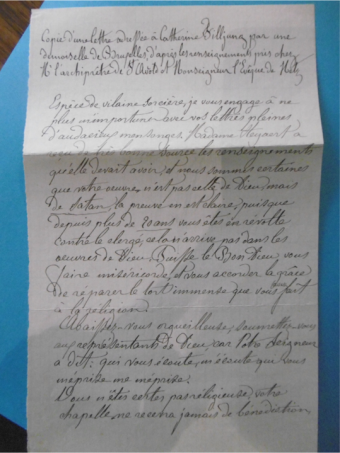by Andrea Graus
“You nasty witch, I urge to stop bothering me with your letters full of lies. […] You are certainly not a religious sister, your chapel will never be blessed, everything in you is a lie, you are an audacious rascal, and beware of coming to Brussels, because if I knew you were here, I will have you arrested.
Do not call me your dear friend anymore, because I don’t want to be a friend of Satan, I hate touching the paper where you write, and do not think that I will give you money to build castles in the air.
Goodbye, my beautiful witch, goodbye…”[1]
This enraged letter of 1894 from a woman from Brussels is directed to Catherine Filljung (1848-1915), once a Dominican sister and an alleged mystic and stigmatic from a town close to Metz. After the annexation of the (today-French) Alsace-Lorraine to the German Empire in 1871, Filljung founded a religious orphanage using donations. She was already known in the region for her charismata, including stigmata and miraculous healing. The Diocese of Metz accused her of deceiving donors with her ‘fake mysticism’. Filljung was tried for fraud, and spent four months in an asylum before the trial. In 1892, The Supreme Court of Leipzig acquitted her, arguing that she suffered from ‘religious madness’ and was not responsible for her actions. Filljung’s was one of the (few) ‘mystic trials’ occurring in Europe in the nineteenth-century. Why did criminal justice take an interest in such matters?
During the Enlightenment, and especially after the French Revolution, many thinkers advocated secularizing the state. They thought that offences against religion should not be punished by law anymore. According to Cesare Beccaria, an influential Italian jurist, offences should only be judged with regard to the damage caused to public peace and safety. Though small fines or police warning against ‘troublesome’ mystics became increasingly common, bringing them before court was an unconventional measure reserved for cases having had great impact in the public opinion and having altered the public order.
A common feature shared by the Christian mystics who were taken to court during the nineteenth century was that their cases had moved beyond an ‘acceptable’ level of religious enthusiasm, arousing the interest of the press and causing public disturbances. These included such inconveniences as uncontrolled gatherings at sites where ‘miracles’ had taken place; roads becoming unusable owing to crowds of pilgrims; illegal commerce in alleged holy objects; indiscriminate publicity of the phenomena; and the spread of political prophecies. In such cases, justice systems treated the events as public disorders and targeted the source of the disturbance. For instance, in Germany Catherine Filljung was declared a ‘danger to public safety’.

Picture of headbands imprinted with the blood of Filljung’s ‘crown of thorns’ during two Fridays of Lent, 1888 (courtesy of Archives de la Province Dominicaine de France, Bibliothèque du Saulchoir, Paris, Catherine Filljung: VI-Q-62bis).
When confronted with the allegedly supernatural, both ecclesiastical commissions and criminal courts dealt with it in terms of facts. However, inside the courtroom, ‘facts’ meant actions related to criminal charges—in these cases, usually fraud. The courts often found it difficult to translate alleged mystical experiences into criminal charges. Filljung initially faced charges of fraud for faking ecstasy and stigmata, and of misconduct for hiding her own (illicit) children in the orphanage. In the end, the judge only retained the accusation of ‘simulation of ecstasies: a criminal means to gain trust’.
As we can see, the criminal charges against alleged mystics referred to only a tiny portion of their mystical experiences. However, it was their mysticism as a whole that was being judged. Unlike canonical inquisition, lawsuits had the power to demystify the defendant’s mystical experiences even before a verdict was pronounced. The task of modern criminal justice is not to assess the reality of the supernatural, but to determine whether a criminal act has been committed. Hence, once a lawsuit was initiated, the implicit message was that the alleged mystic was a fraud.
If lawyers could not demonstrate fraud or other charges, declaring the defendant mentally disturbed proved to be effective in suffocating religious enthusiasm. In the few cases where the defendants were declared not guilty – such as Filljung’s case – the acquittal was supported by a psychiatric diagnosis, usually of hysteria. In this way, the judges were able to conclude that, although the ecstasies and other phenomena may have been real, they were a natural occurrence produced by a mental disorder. The defendant was not a trickster, nor did she have any intention to deceive; but neither was she on a divine mission. The medicalization of religious experience allowed some mystics to be acquitted, but at the high price of having their mysticism reduced to a psychiatric diagnosis.

“The truth about Catherine Fillujung. False mystic” by J.-B. Pelt, Bishop of Metz.
After the trials, the defendants never managed to shake off their ‘false mystic’ reputation, and – as the letter cited above demonstrates – lost the majority of their supporters in and outside their country. In this vein, the risk of staging such trials was be very limited, and their effects, which the defendants deemed ‘calumnious’, continue today. Despite recent attempts by theologians to vindicate the ‘true mysticism’ of Filljung,[2] today she is mainly remembered as a ‘false mystic’.
For more information see:
Andrea Graus, “Mysticism in the courtroom in 19th century Europe”, History of the Human Sciences, 31(3), 2018: 21-40 Download article (Open access)
[1] Archives de la Province Dominicaine de France (Paris), VI-Q-62bis, box 0-12, dossier 11, ‘Lettre d’une demoiselle de Bruxelles, 1.12.1894’
[2] Seewann, M.-I. (2009/2011) Catherine Filljung (13.4.1848-4.8.1915). Dans les controverses des opinions. Documentation de la vie extraordinaire de Sœur Rose OP. Vol. 1&2. Wien: M.-I. Seewann.

